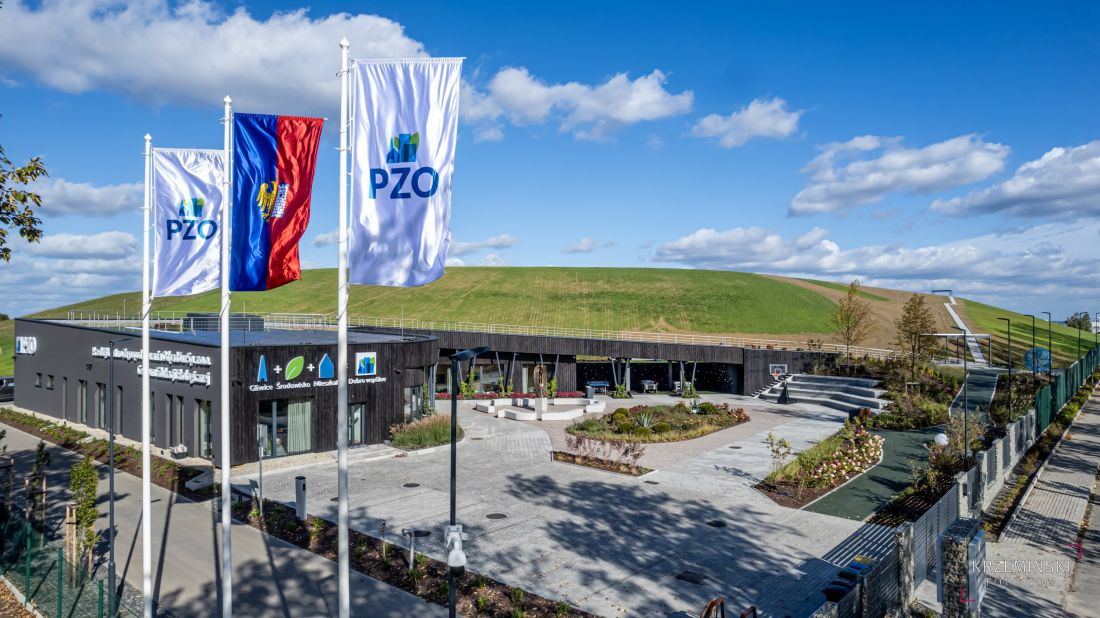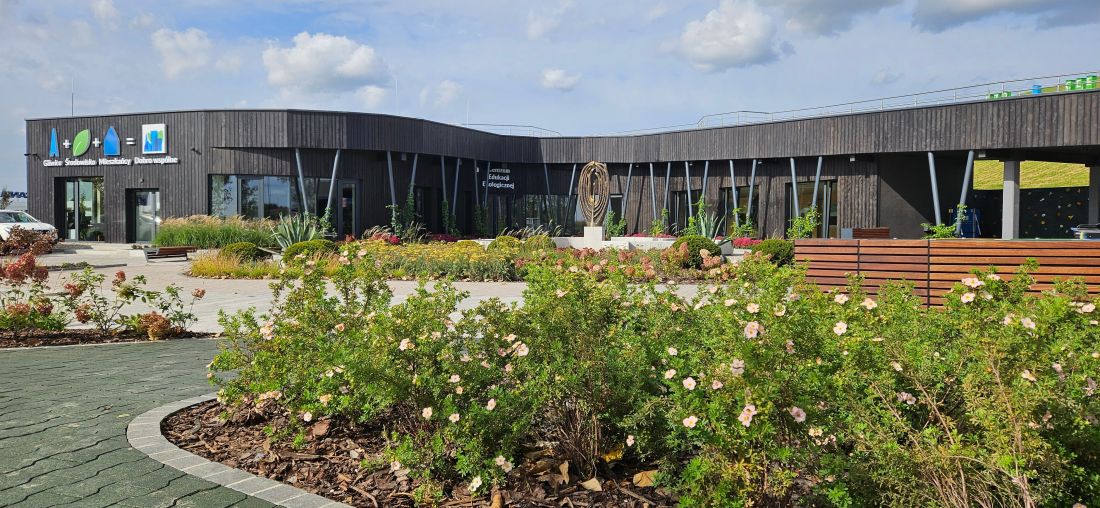An Environmental Education Center has been opened in Gliwice at Rybnicka Street after three years of intensive work. The new investment of the Waste Management Company was designed by Studio BB Architekci. At the CEE one can learn how to care for the environment, play interactive games, watch movies, stroll along educational paths, climb the green roof and visit the minizoo. Still in the design phase, the Gliwice building won the PLGB award in the Best Environmental Project category in 2021.
Center for Ecological Education in Gliwice
Photo: K. Krzeminski, PZO press materials © Studio BB Architekci
The one-story CEE building with a green roof, located in the vicinity of the landfill, serves two functions: day-to-day supervision of the landfill and waste management, and educational awareness of children and young people.
On the roof, which can be accessed by the architects, they designed an educational path, photovoltaic installations and provided space for beehives for bees. Meanwhile, in the zone of the rising roof, the designers incorporated steps for seating.
In the plaza in front of the building, small architecture forms a bird's-eye-view sign symbolizing recycling. Meanwhile, at the central point stands the sculpture Vita Granum Gliwice—Gliwice Seed of Life, depicting hands surrounding a sprouting seed. For the uninitiated, Vita Granum Gliwice is also the name of a soil improver made from Gliwice's bio-waste.
The author of the Vita Granum Gliwice sculpture is Prof. Krzysztof Nitsch
photo: T. Bradecki © Studio BB Architekci
From the pre-entry area you can take two educational paths: the first leads to the roof of the CEE, and the second climbs to the reclaimed waste quarters. There, you can walk through a section of the reclaimed landfill and watch the landfill work from a safe distance.
Inside the Environmental Education Center there are offices, social rooms, and the most important:an exhibition and education room, and a conference and education room. The exhibition consists of interactive games, animations, educational information and infographics. The theme is waste management, including segregation and recycling.
The Center for Environmental Education in Gliwice is a one-story building
Photo: T. Bradecki, PZO press materials © Studio BB Architekci
interview with Studio BB Architekci
Dobrawa Bies: In 2020 we published in the A&B portal the project of the Center for Ecological Education in Gliwice, of which you are the author. Now after three years we are talking about the completed facility. The end of October this year saw the official opening of the Education Center. Do you feel satisfaction?
Tomasz Bradecki, Barbara Uherek-Bradecka, Pawel Gembalczyk: Yes we are very satisfied for many reasons. The first is that the Environmental Education Center is not just a building, but it is a new place that integrates landfill space, public space and office and exhibition space. At the idea and concept stage, we didn't know that this would be an Environmental Education Center—the investor's idea was to create an unusual building, and its functions beyond office needs were not obvious. Today it is clear. Ecological education centers function in Europe and Poland, and they share a common idea, but each of them is different, manifests its true function in different ways, and only some use the full range of technical possibilities. In our opinion, this is the only environmental education center implemented on an existing active landfill site in the vicinity of a reclaimed waste quarter. It was a design and organizational challenge. At the same time, this is the potential of the site: i.e., the immediate vicinity, one of the greatest challenges of the modern world—waste management.
The design premise was to fit the building into the plot of land
© Studio BB Architekci
Dobrawa: Was the building realized without any changes from the original design?
Tomasz Bradecki, Barbara Uherek-Bradecka, Paweł Gembalczyk: The realization of the building brought a few changes from the design—this was dictated by local conditions. We discussed the development of the site for a long time. Originally we assumed a square with a dry plaza-type fountain, and the focal point was to be an unspecified element. Today, it is the sculpture Vita Granum Gliwice—Gliwice Seed of Life, whose author is Gliwice-based, prominent sculptor and medalist, Prof. Krzysztof Nitsch. It symbolizes caring hands surrounding a sprouting seed. It fit in perfectly, breaking the technical nature of the building.
Unfortunately, the high level of groundwater and the nature of the site did not allow us to realize the fountain. We also considered a local retention basin. In the end, an island of greenery was created. And this is probably the simplest and most ecological solution. According to the project, we planned a path to the top of the reclaimed quarters, from which the open quarters, where heavy equipment operates and cleans up and dumps waste, would be visible (safely for visitors). The course of this path and its form were various (length of more than 150 meters, elevation of about 9 meters). The final realized version of the path is undoubtedly optimal—in about 8 minutes of walking we can go out to one of the highest hills in Gliwice and see how waste is really managed.
The architects also designed a path to the top of the recultivated quarters
Photo: G.Ożga, PZO press materials © Studio BB Architekci
Dobrawa: Please tell us about the stages of construction. What was the biggest challenge?
Tomasz Bradecki, Barbara Uherek-Bradecka, Pawel Gembalczyk: Implementation in the vicinity of the reclaimed quaternary was a challenge, because waste management a few decades ago looked a bit different. This had a direct impact on the bearing capacity of the soil, or rather the lack thereof in the layers near the surface. For this reason, the one-story building was founded on a foundation slab, and the slab itself is set on dozens of piles.
The second challenge turned out to be the realization of a trapezoidal sheet floor supported by glulam beams. Both materials can be considered environmentally friendly, as they can be reused and are easily dismantled in the future. However, the entire roof and form of the building creates a sloping non-linear form, which made it necessary to use unusual solutions. The fact that the sloping roof has a nature trail and a green area also did not make the task any easier.
An educational exhibition awaits visitors to the CEE
Photo: G. Ożga, Gliwice City Hall © Studio BB Architekci
Dobrawa: How does the facility meet the objectives of environmental education? Who are its recipients?
Tomasz Bradecki, Barbara Uherek-Bradecka, Paweł Gembalczyk: Most elements of the CEE meet the assumptions of education—we wanted to expose them, from the sloping form of the building starting with the technical elements. The materials used (wood on the facade, greenery on the roof) support this effect.
The recipients are primarily children and teenagers, but not only. Adults will also find inspiration here. The permanent exhibition has been prepared mainly to meet the needs of pre-school and school children, but older people will notice professional films and collected data on garbage here, which make them aware of how big and complicated the problem is.
Dobrawa: Thank you for the interview.


















































